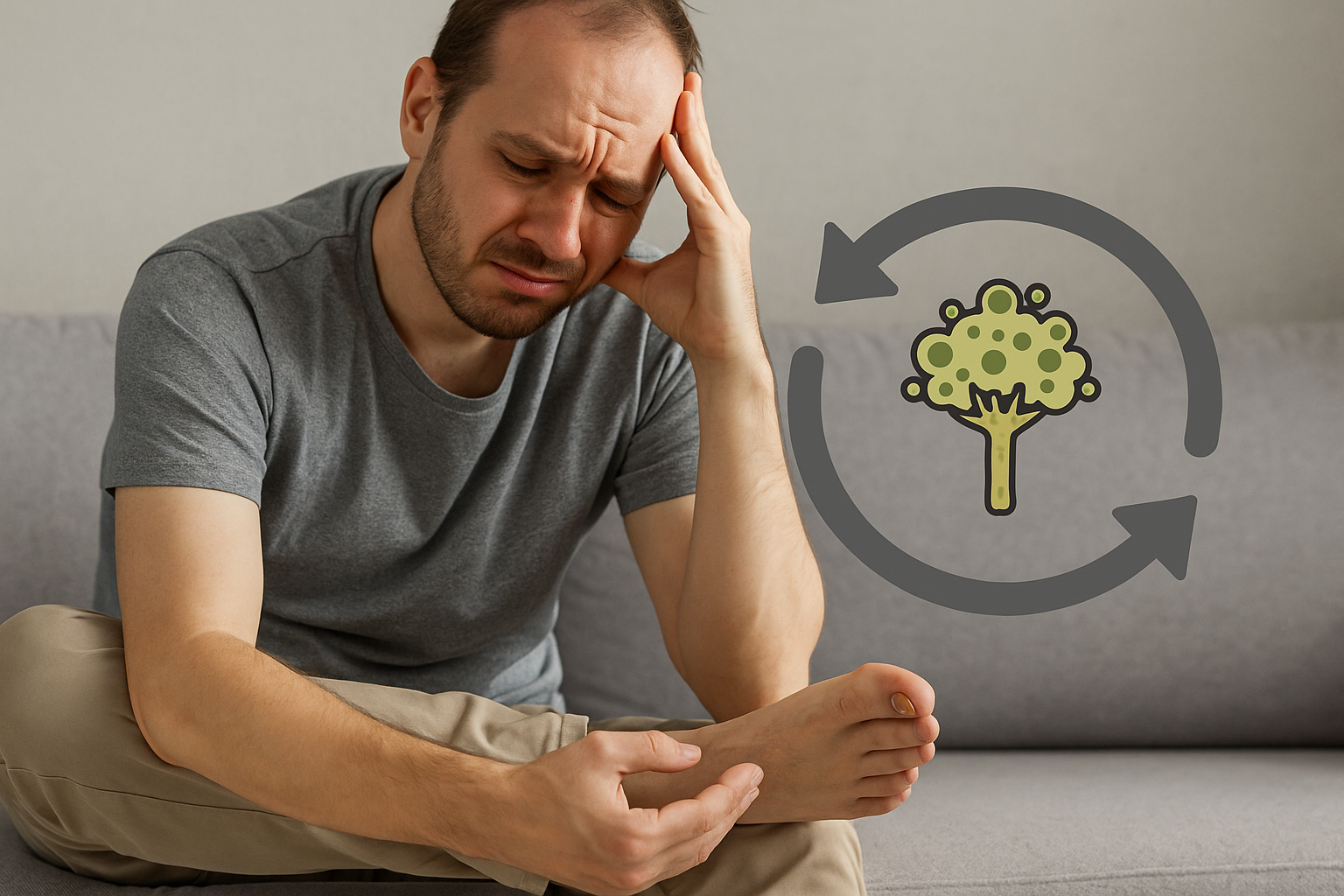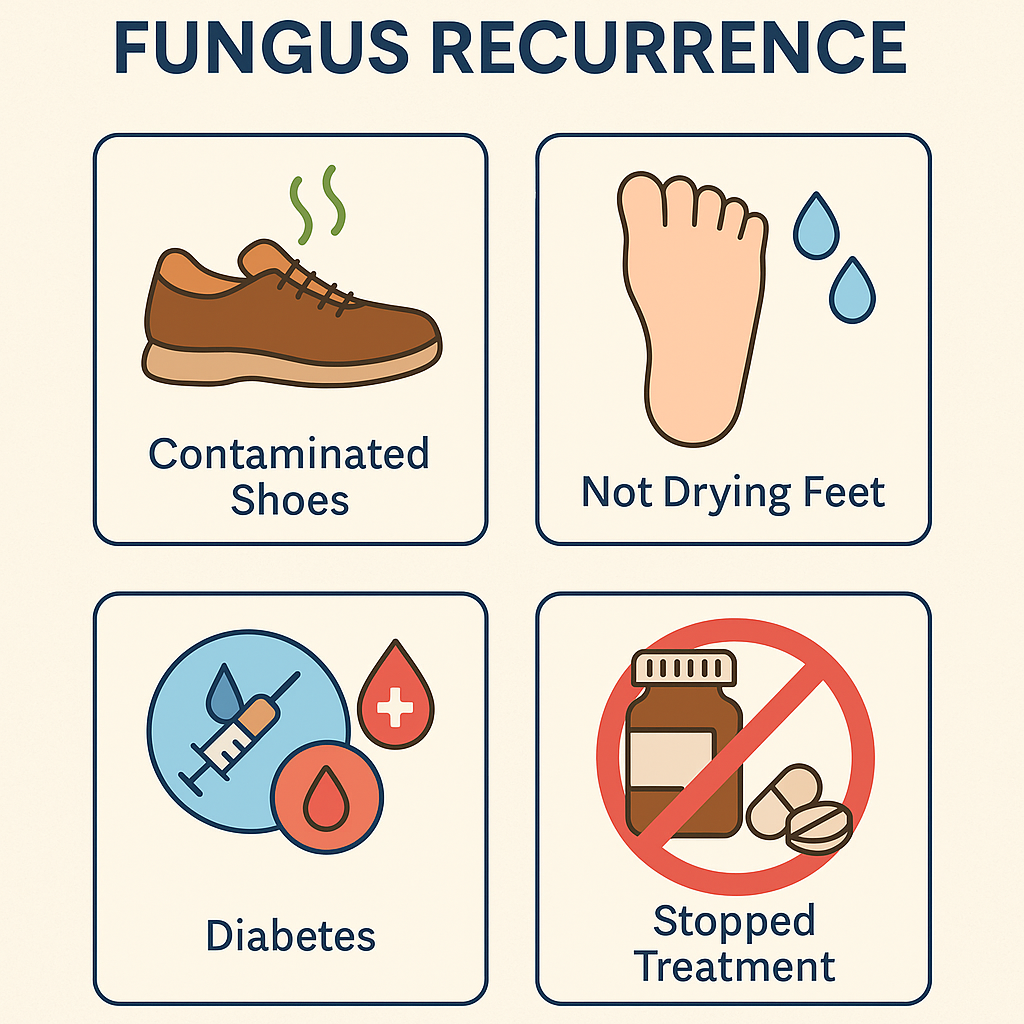🦶 Recurrent Toenail Fungus? Discover Why It Happens & How to Break the Cycle!
By Wagner F., Independent Health Researcher
Reviewed by Liliane C., Podiatrist with 15+ years of experience

Why Does Toenail Fungus Keep Coming Back? Understanding the Recurrent Onychomycosis Cycle
Have you treated toenail fungus once, twice, maybe three times, and it just doesn’t go away—or it comes back shortly after? This frustration is common among those dealing with onychomycosis, the fungal nail infection. More than a cosmetic issue, recurrence may indicate that something in the treatment cycle or your daily habits is being overlooked.
Understanding why the fungus keeps returning is the first step to breaking this vicious cycle. In this comprehensive guide, we’ll explore the reasons behind recurrent onychomycosis and the most effective strategies to finally eliminate it and keep your feet and nails healthy long-term.
Common Causes of Recurrent Toenail Fungus
Onychomycosis is stubborn, and its persistence is often due to a combination of factors. Here are the main reasons why the fungus might keep reappearing:
1. Inadequate or Interrupted Treatment
- Insufficient Duration: Many stop treatment as soon as improvement appears, but fungus may still be present under the nail. Treatment usually takes 6 to 12 months until the nail grows out healthy.
- Inconsistency: Skipping doses or applications—even for a few days—lets the fungus bounce back stronger.
- Wrong Treatment Choice: Not every treatment works for everyone. Some fungi are more resistant, or the product chosen may not be potent enough for the infection’s severity.
2. Constant Reinfection from the Environment
- Contaminated Shoes: Warm, moist, dark environments like shoes are ideal for fungal growth. Without disinfection, they can reintroduce fungus immediately after treatment.
- Socks: Synthetic materials or reused socks without proper washing can harbor fungus.
- Public Areas: Pools, gym showers, locker rooms, and damp floors can reinfect feet if walking barefoot.
- Nail Tools: Contaminated clippers or files can spread the fungus between nails or cause reinfection.

3. Underlying Health Conditions
- Diabetes: Poor circulation and immunity make fungal infections harder to cure.
- Weakened Immune System: Autoimmune diseases, immunosuppressants, or other conditions reduce the body’s ability to fight infections.
- Poor Circulation: Reduced blood flow to feet and nails limits nutrient delivery and antifungal penetration.
4. Lifestyle and Hygiene Habits
- Moist Feet: Not drying feet completely after bathing, especially between toes.
- Tight/Closed Shoes: These promote a warm, humid environment ideal for fungus.
- Untreated Athlete’s Foot: Skin infections on feet often cause reinfections in nails. Many treat the nail but forget the skin.
Signs That Treatment Isn’t Working or the Fungus Is Back
- No Improvement: Nail looks the same or worsens even after consistent treatment.
- New Symptoms: Itchy skin, redness, scaling, or discoloration spreading to other nails.
- Thickened or Detached Nails: Nail becomes yellow, brittle, or separates from the nail bed again.
- Persistent Odor: A fungal smell that remains despite hygiene.
Advanced Strategies to Break the Cycle
Strict and Complete Treatment
- Follow your doctor or podiatrist’s full treatment duration—even if nails look healed.
- Apply the treatment consistently, without skipping.
Environmental & Habitual Decontamination
- Shoes: Disinfect with antifungal spray or UV sterilizers. Consider discarding old shoes.
- Socks: Wear breathable cotton, wash in hot water, and add vinegar or disinfectant.
- Foot Hygiene: Dry thoroughly, especially between toes. Use antifungal powder daily.
- Public Spaces: Always wear sandals in wet areas.
- Tools: Use personal tools and disinfect with alcohol after each use.
Internal Support: Strengthening Your Natural Defenses
External treatment is essential, but your body needs internal support to fight off infections and prevent new ones. Certain nutrients and natural compounds boost the immune system and create an unfavorable environment for fungi.

Key Ingredients:
- Garlic Extract (Allicin): Powerful antifungal properties.
- Oregano Oil (Carvacrol & Thymol): Proven antimicrobial effects.
- Probiotics: Gut health supports a stronger immune system.
- Caprylic Acid: Antifungal fatty acid especially effective against yeasts.
- Vitamins C & E, Zinc, Selenium: Crucial for immune and skin/nail health.
Always consult a doctor or nutritionist before adding supplements to your routine.
Don’t Ignore Athlete’s Foot
Treat skin infections at the same time as nail fungus—they are a common reinfection source.
When to See a Doctor
- If the fungus doesn’t improve with home treatment.
- If the infection spreads or becomes painful.
- If you have diabetes or compromised circulation/immunity.
Conclusion: Break the Cycle and Reclaim Healthy Feet
Recurring toenail fungus can be discouraging, but with the right approach, you can finally break the cycle. The key lies in consistent treatment, environmental hygiene, and strong internal support.
Don’t let fungus hold you back. Understand the root causes, adopt internal and external strategies, and enjoy healthy, confident feet again.
👉 Ready to Strengthen Your Defenses?
Discover the best natural supplements to support your body in fighting and preventing recurring fungus.
Frequently Asked Questions (FAQ)
- Why does toenail fungus always come back?
Due to incomplete treatment, contaminated shoes, or weakened immunity. - How long does it take for toenail fungus to disappear?
6 to 12 months, depending on nail growth and treatment consistency. - Can I wear my old shoes?
Yes, but disinfect them rigorously. - What vitamins help fight fungus?
Vitamin C, E, Zinc, Selenium. - Do probiotics help?
Yes! They support the immune system from within.
© 2025 LabOfficial.shop — Content by Wagner F., reviewed by Liliane C., DPM

🔎 Medical & Health Disclaimer: This article is provided for informational and educational purposes only. It is not intended to be a substitute for professional medical advice, diagnosis, or treatment. Always consult a qualified healthcare provider before starting any new supplement or treatment, especially if you have a chronic health condition, are pregnant, nursing, or taking medication.
🔗 Affiliate Disclaimer: Some links on this page may be affiliate links. This means if you click and make a purchase, we may earn a small commission **at no extra cost to you**. This helps support our independent research and allows us to continue providing valuable content and recommending natural health solutions.
This page may direct you to a carefully curated list of top-rated natural supplements for foot and nail fungus. We are committed to recommending only products with verifiable user results, transparent formulations, and a strong safety profile.

Wagner P
Natural Health Researcher & Founder of LabOfficial
Wagner is dedicated to researching and testing safe, natural solutions for everyday health problems. Through LabOfficial, he shares effective home remedies and recommends science-backed supplements that simplify healing and restore well-being without side effects.
Disclaimer: The information contained in this article is for educational and informational purposes only. It is not a substitute for professional medical advice, diagnosis, or treatment. Always seek the advice of a qualified health professional before starting any new diet, exercise program, or supplementation.